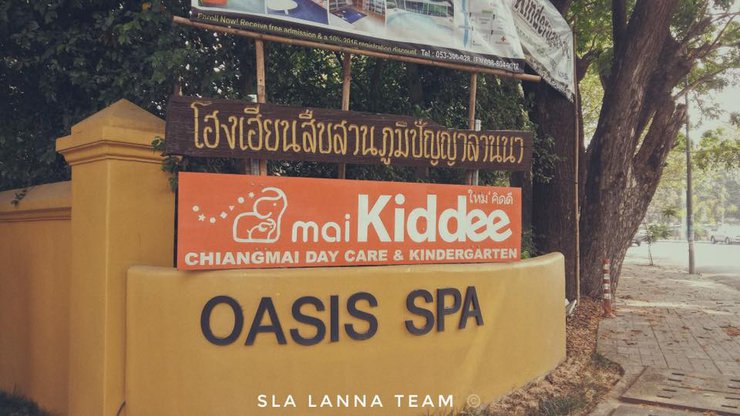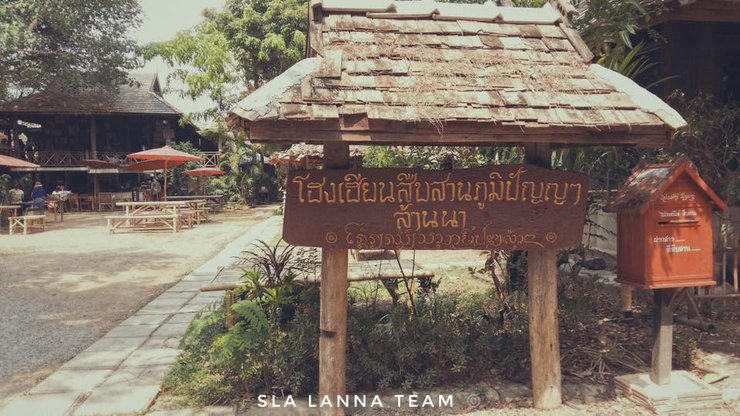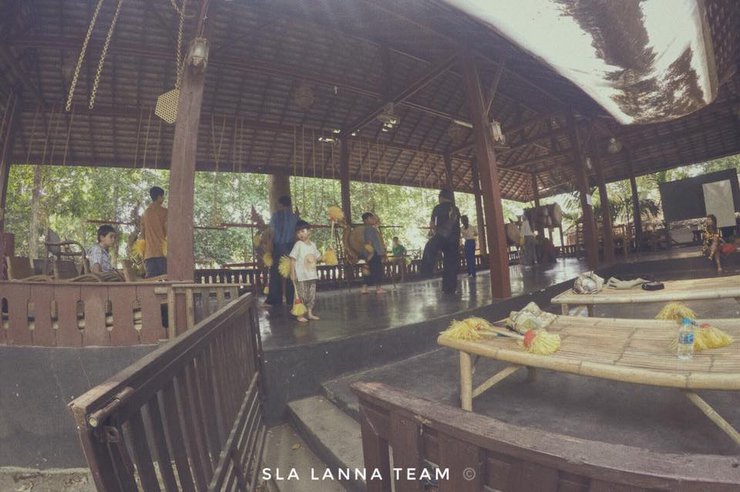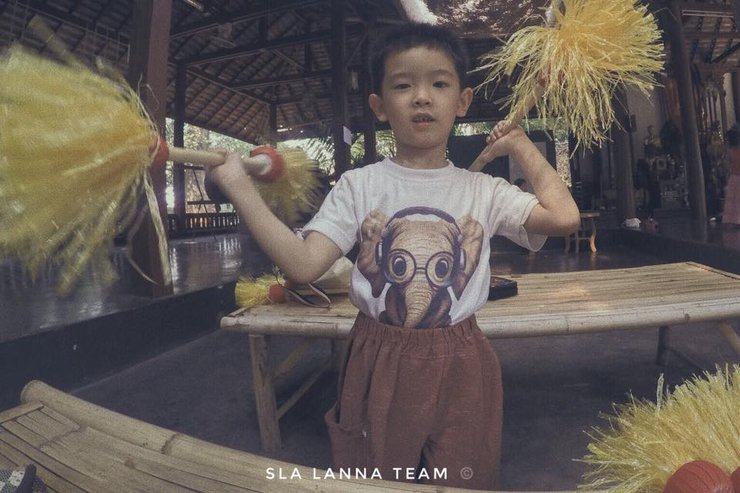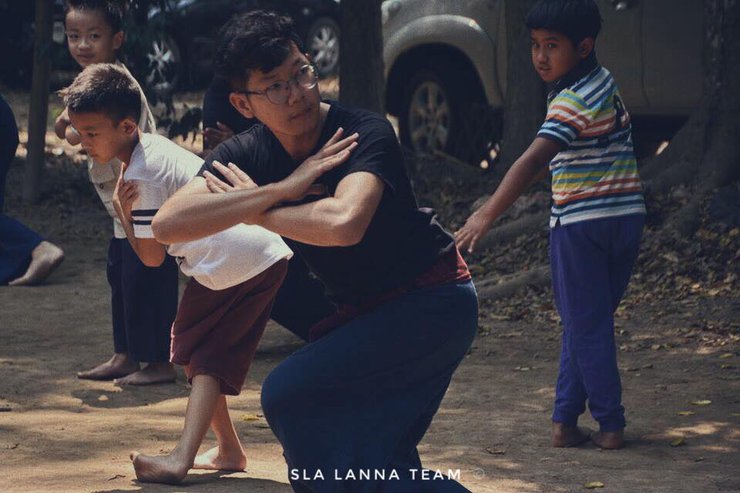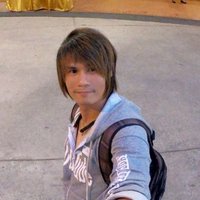Returning to the Roots: Rediscovering Chiang Mai at Sla Lanna
The Traditional Wisdom Lanna School at Sla Lanna offers a unique opportunity to delve into the heart of Chiang Mai's cultural heritage. This immersive experience invites participants to reconnect with the city's essence through a journey of rediscovery.

Let's preserve our local art forms together.
If we don't work together to preserve them, they will disappear.
Jatupol Sing-onkaw
Klong Sabadchai Drum Teacher
Ho Hean Lanna Wisdom Continuation Center, Chiang Mai
Chiang Mai: Beyond the Tourist Trail
Forget the ornate Lanna temples, the misty mountain peaks, and the vibrant nightlife. If you're seeking these familiar facets of Chiang Mai in the following narrative, you might be disappointed. However, if you yearn for a genuine encounter with Lanna culture, then follow us on a journey that reveals the hidden treasures of this captivating city. You'll discover that Chiang Mai offers a wealth of experiences beyond the well-trodden tourist path.

Less than half an hour north of Chiang Mai city lies 'Hoeng Hian, the Lanna Wisdom Inheritance Center'. In the central language, 'Hoeng Hian' simply means 'school'. Just hearing the word 'school' might make some people cringe, but wait a minute. Open your mind for a moment. If you haven't been to this 'Hoeng Hian' yet, don't rush back. You'll discover that Chiang Mai has much more to offer.
Hoeng Hean: Preserving Lanna Wisdom
Located in Wat Ket Subdistrict, Mueang District, Chiang Mai Province, Hoeng Hean was established in 1999 to collect knowledge from local teachers, elders, and scholars. Its mission is to transmit traditional wisdom to future generations and interested individuals within the community. This fosters learning and the continuation of various local wisdoms. Additionally, Hoeng Hean serves as a hub for developing existing local knowledge into diverse forms, enabling younger generations to continuously inherit the knowledge accumulated by their ancestors.

A visit to the Hoeng Heian Cultural Center offers a comprehensive immersion into Lanna culture. From the rhythmic beats of the "Klong Sabat Chai" drums to the graceful movements of the "Fon Dern" and "Fon Jeng" dances, the center showcases the rich tapestry of Lanna traditions. Visitors can delve into the melodious sounds of the "Fong Luang" music and witness the intricate craftsmanship of "Jak Rasan" weaving and "Kraw-So" embroidery. The center also provides insights into the fascinating world of "Tungk-Khom" lantern making, traditional children's games, and the art of woodcarving. Through interactive exhibits and demonstrations, visitors can gain a deeper understanding of the "Salawan" architectural style and the wisdom of Lanna medicine.

The initiative begins with the "Wichian Klong Sabad Chai" program, led by Mr. Chatuporn Sing-onkaw, also known as Kru Ford. Kru Ford, a young teacher, utilizes his university break to teach Klong Sabad Chai drumming to children, hoping to instill a love for this art form in the younger generation and ensure its continued传承.

The Chaisabat Chai drum has existed for centuries. In the past, it was used to beat during wartime to bring good luck and encourage soldiers to fight for victory. The melodies used to play the ancient Chaisabat Chai drum have three melodies: Chai Pheri, Chai Dithi, and Chana Mara. Playing the Chaisabat Chai drum is a form of Lanna folk art, which is often found in processions or folk art performances in general in recent times. The style of playing is exciting and uses various parts of the body, such as elbows, knees, and head, to play.

Please Translate:

Fon Jeng is a dance that follows a set of movements that express the art of male combat. The dance moves include both individual movements and movements that allow each dancer to use their own skills to create beautiful variations, such as Fon Jeng with a mallet, Fon Jeng with a spear, Fon Jeng with a sword, or Fon Jeng with bare hands.
There is no text to translate. Please provide the text you want me to translate.

The training of Fon Jeng begins with practicing footwork, which involves stepping with proper form. This is done by practicing stepping according to the "khum jeng," which is a diagram or designated positions, often marked by stakes, bricks, or stones placed in the correct locations. Stepping must follow the "khum" in both the receiving and evading phases. Simultaneously, the hands must be drawn out in a way that corresponds to the stepping foot to maintain balance and for aesthetic purposes.


Flower swaying in this context does not refer to flowers swaying in the wind, but rather to ornaments made of brass sheets. The origin of this tradition can be traced back to the practice of visiting temples on important religious holidays in the past. People would bring various flowers grown in their gardens, incense, candles, and a suai (cone) made of banana leaves, all placed in a salung ngern (silver bowl), to offer at the temple. Young Lanna women with long hair would style it in a bun and adorn it with flowers when visiting the temple. This was a way of paying respect to their heads and, when bowing, to the Buddha. It reflects the belief in the worship of the khwan (spirit) among the Tai-Lao people.
Currently, the use of "Dok Mai Wai" flowers for decoration in various performances is more popular than using them as offerings at temples. Metal "Dok Mai Wai" flowers come in various designs, but the most popular ones are those made into bouquets, such as orchids, champaca, sesbania, and Murraya paniculata.

Crafting the Waving Flower (Puttal Flower)
Materials:
- 5x5 inch brass sheet (pre-cut from a shop)
- Garland needle
- Brass wire
Procedure:
1. Cut the paper into 3*3 cm squares.
2. Imagine the characteristics of a flower without any prior design.
3. Cut into four equal petals on all sides.
- Carving (flower petal carving)
5. The petals of the flower are bent according to the shape of the petals (personal technique, depending on the artist).
6. Create a spring - Use brass wire wrapped around a needle.
- Puncture a hole through the center of the flower petal.
8. Composed by arranging the outermost petals to rotate inwards.
9. The addition of diamonds or gemstones to the flower for aesthetic purposes is a matter of personal preference.
10. To enter the stem, all five flowers must be completed.
11. Wrap the wires together, insert the brass rod, and squeeze the front to narrow it.
- To obtain one bouquet, additional leaves may be added as desired.



Writing on Khrueang Khein: Khrueang Khein is a handicraft of the Lanna people, influenced by the Tai Khein. It is a container with a woven or wooden frame, coated with lacquer for durability, water resistance, and moisture protection. This also enhances the beauty of the container's surface. Lacquer is applied in multiple layers, with the final layer being decorated for aesthetic purposes. This may involve painting patterns, applying gold leaf, or carving the surface to create deep grooves and then inlaying different colored lacquer to form beautiful patterns.



In addition, there is a Lanna painting class. The teacher will first teach students to draw patterns on paper to practice their skills. The patterns taught include bird patterns, branch patterns, and so on. Once they are proficient, students are then allowed to draw on small umbrellas. This class is very popular with the children, who chat happily with the teacher. The skills of each student are truly remarkable.


Dance




Natural Dyeing Techniques: A Sustainable and Safe Approach
This course focuses on the art of natural dyeing, emphasizing a safe and sustainable approach. Students will learn the entire process, from preparing the materials to extracting natural dyes from various sources, such as tree bark. The course emphasizes the use of natural dyes, ensuring the safety of the dyeing process for both the environment and the user's health. The final stage involves dyeing fabrics without the use of harmful chemicals, promoting a more environmentally friendly and sustainable practice.



**History of Lanna**

Lanna Language

After immersing yourself in the Lanna studies, don't forget to stop by the museum at the far end. Here, you can find exhibits showcasing the local wisdom, tools, and ancient artifacts of the Lanna people, enriching your knowledge even further.



You can easily spend the whole day at Hoeng Hean without worrying about food. At lunchtime, there is a noodle shop in front of the office building that offers affordable and delicious meals.

Or in the afternoon, if you want to have a coffee, there is a cafe in the middle of the courtyard with bamboo benches for resting. If you want to relax and enjoy the atmosphere of the Lanna wooden houses, accompanied by the sound of the "Sabat Chai" drums and watch the children practicing traditional dances, you can experience a different kind of atmosphere. Plus, you don't have to worry about spending a lot of money if you have to stay all day, because admission is free. And all the courses taught are completely free (except for special courses that are offered as specific courses for a few months, which will have a cost of 1,500 baht for materials). So, next time you come to Chiang Mai, don't miss it.


For those who love shopping, if you stay until late afternoon, there will be a shop selling handicrafts, including bags, tie-dye shirts, shoes, etc., for you to choose from. The shop is located under a large tree, with products displayed on bamboo mats and baskets. The setting sun and the gentle breeze create a pleasant atmosphere that is not too hot. Be careful not to get carried away with shopping and lose your wallet!

The Enduring Legacy of Lanna Wisdom: A Call to Action
While some may find this journey tedious or lacking immediate appeal, it is our hope that by introducing you to the "Hoeng Hean: Preserving Lanna Wisdom" school, we have sparked a deeper appreciation for the invaluable cultural heritage of the Lanna people. The ancient wisdom enshrined within these traditions is at risk of fading from memory, and it is our collective responsibility to ensure its preservation.
This article serves as a beacon, illuminating the path towards cultural preservation. Even if it reaches only a single individual, its purpose is fulfilled. Remember, "If we do not unite to safeguard our heritage, it will vanish, lost forever."
Let us not allow the rich tapestry of Lanna culture to fade into oblivion. Let us embrace the responsibility of custodianship and ensure that future generations inherit the wisdom and beauty of their ancestors.

Contact
Preserving Lanna Wisdom
35 Ratchadamnoen Road, Wat Ket Subdistrict, Mueang District, Chiang Mai 50000
053 244 231, 08-1111-2527 (Mr. Yutthakarn)
Facebook: Preserving Lanna Wisdom
Email: [email protected]
References:
http://www.creativechiangmai.com/en/orgview.php?or...
https://www.bloggang.com/m/viewdiary.php?id=rouenr...
Chatkamon Piyajaruporn
Wednesday, February 26, 2025 4:41 PM





